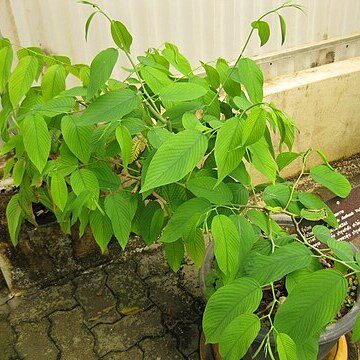Shrubs scandent or erect. Young branches yellow-green, smooth, glabrous. Stipules narrowly lanceolate, 1-2 mm, persistent; petiole 1-2 cm, rarely to 5 cm, glabrous; leaf blade abaxially dark brown when dry, adaxially green, ovate or ovate-elliptic to elliptic, 4-9(-11) × 2-5(-6.5) cm, papery, abaxially glabrous, or sparsely pubescent on veins, adaxially glabrous, lateral veins 9-12 pairs, prominent on both surfaces, base rounded to cordate, margin entire, apex obtuse to rounded, or acute to acuminate. Inflorescences to 15 cm; lateral branches less than 5 cm; rachis glabrous or sparsely puberulent. Flowers numerous, glabrous, few in fascicles, in terminal cymose panicles or axillary cymose racemes. Pedicel 1-2 mm. Calyx tube shallowly patelliform, glabrous; lobes narrowly triangular, adaxially distinctly keeled up to middle. Petals spatulate, enfolding stamens. Disk thick, fleshy, centrally distinctly convex. Ovary nearly completely immersed in disk; style cylindric, undivided; stigma 2-or 3-lobed. Drupe red, bluish black at maturity, cylindric-elliptic to ovoid-oblong, 7-10 × 4-5 mm, with persistent cup-shaped disk; stone 2-loculed; fruiting pedicel 2-3 mm, glabrous. Fl. Jul-Oct, fr. Apr-Jul of following year.
More
A large twining shrub. The twigs are cylinder shape and tapering. The leaves are 5-12 cm long by 3-4 cm wide. They are narrowly oval. They are more pale underneath. The flowers are in tufts of 3-6. They are in large groups 12-15 cm long at the ends of branches. The fruit is fleshy and 8-20 mm long. The seed is covered in a hard coat and is flattened and smooth.


